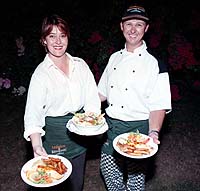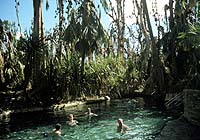Australia's Top End is a lazy adventurer's paradise. But plan your trip first to avoid disappointment. The thing that strikes you most about Kakadu, as with much of the Northern Territory, is just how ancient the landscape is. Stark, rugged and often inhospitable, it is these unlikely qualities that draw hundreds of thousands of visitors there every year.
Australia's Top End really does offer a unique travel experience. Once amongst it, it's easy to sympathise with the small army of protestors currently encamped there, defending this World Heritage listed area against mining interests.
Travelling around the park is basically trouble-free, with sealed, well-maintained roads leading to the major sights and attractions. There are several rougher 4WD tracks for the more adventure-minded tourists that take you out to such attractions as Jim Jim and Twin Falls and the Alligator Billabong campground.
My strongest recommendation before visiting Kakadu is to do your homework first. Not all the attractions and activities will appeal to everybody, so it is important to pinpoint beforehand the sort of things that you, in particular, want to do and see. Some will want to get up close to wildlife, others will enjoy the ample bushwalks, while another group might want to enjoy the solitude and peace of a secluded campsite somewhere.
Accommodation is expensive within the park. We paid $145 for a three bed cabin in The Kakadu Frontier Lodge at Jabiru. The same thing would be $50-$60 anywhere else in the country, while we were asked to part with $25 per head for what was really only backpacker-level huts at The Gagudju Lodge, Cooinda. Camping or caravans are a good idea in Kakadu! It also pays to bring food with you where possible, so stock up at Coles in either Katherine or Darwin before you head in. To be fair, once you've paid $15 per head at the park gates, most of the sightseeing is free. The maintained walking tracks with guides, visitor centres, amenities, brochures and information boards are of a very high standard and definitely add to your experience and understanding of this special place.
Although we missed it, Litchfield National Park should be on your must-see list. Smaller and more compact than Kakadu, it is nonetheless a definite attraction in this bountiful region. Home to numerous beautiful waterfalls, rainforests and perennial spring-fed streams, its 143 square kilometres have only been proclaimed a park since 1986. South To The Edge Of The End Seventy kilometres from Kakadu's southern gates you'll find the quaint little township of Pine Creek. Steeped in pioneering, mining, and goldrush history, it is now basically a tourist stop and well worth the minor detour. Gold was discovered there during the construction of the Overland Telegraph line in 1871, and along with tin, is still being mined in varying amounts to this day.
A further 115 kms south is the major centre of Katherine, now mostly back on its feet after severe flooding earlier in the year. All levels of accommodation are available here, as well as shopping, fuel and repairs. We enjoyed excellent rooms at both the All Seasons and Knotts Crossing for around $90. Pop into "Gallop Thru Time" behind the main street, or visit Mimi Arts and Craft across the old railway line for reasonably priced souvenirs.
Our other meal was had after dark on the banks of the Katherine River while on the popular "Croc Spot Tour". Not for the feint-of-heart, your starlit dining room is shared with a couple of local crocodiles whose dinnertime happens to coincide with yours! We had mixed impressions of our Katherine Gorge cruise, which runs on a busy schedule from near the Nitmiluk National Park visitors' centre. Our barge was full to a man, which made maneuvering for photos or video difficult and often disturbing to others. The beauty of the Gorge was somewhat overshadowed by our discomfort and we gazed with some envy at the unencumbered soles paddling blissfully in rented canoes.
Another increasingly prominent part of the Top End's history is the refocused attention on our wartime activity in the once frontline theatre. Airfields, cemeteries and abandoned bases stand testament to the bravery and urgency of the time. Our most northern towns, in particular Darwin, were subject to over one hundred Japanese air raids during the Second World War with a great many Australian and Allied personnel falling victim during the attacks. One of the largest such memorials is the War Cemetery at Adelaide River, 112 km south of Darwin. Travelers to the Top End don't need to make many special considerations for road travel. Probably the most obvious difference to other states is the absence of a speed limit on the highways. Our muscly V8 Holden Suburban had plenty of go, but one mustn't be drawn into unnecessarily high speeds. Most highway traffic travels safely at around 120-130 km/h, but trucks still travel at just 100 km/h and some of the larger road-trains even slower. Be sure to back off well before you approach a heavy vehicle from behind.
Story and photographs
by Rod Eime
The
author would like to thank Isuzu
GM, Shell and
the Northern Territory
Tourist Commssion who helped in the creation of this story.
|
 GET
BEST RATES FOR KAKADU HOTELS
GET
BEST RATES FOR KAKADU HOTELS Katherine
is also a good place to treat yourself to a restaurant meal. On strong
local recommendations, we tried out two of the several options available.
At the Walkabout Restaurant in the local Country Club, Rob Garvin and
Stacey Kerr put on a famous feed of modern Australian bush tucker that
includes all the usual - camel, croc, barramundi and buffalo. Rod has
catered for such notables as the ABC's Bush Tucker Man and Land Rover.
Katherine
is also a good place to treat yourself to a restaurant meal. On strong
local recommendations, we tried out two of the several options available.
At the Walkabout Restaurant in the local Country Club, Rob Garvin and
Stacey Kerr put on a famous feed of modern Australian bush tucker that
includes all the usual - camel, croc, barramundi and buffalo. Rod has
catered for such notables as the ABC's Bush Tucker Man and Land Rover.
 Further
south again, and on the edge of the Top End is Mataranka, where
you can dip in the famous thermal pools and tour the old homestead that
is now part of a resort. The town is popularly known as the capitol
of the "Never Never" after Jeannie Gunn's famous book.
Further
south again, and on the edge of the Top End is Mataranka, where
you can dip in the famous thermal pools and tour the old homestead that
is now part of a resort. The town is popularly known as the capitol
of the "Never Never" after Jeannie Gunn's famous book.